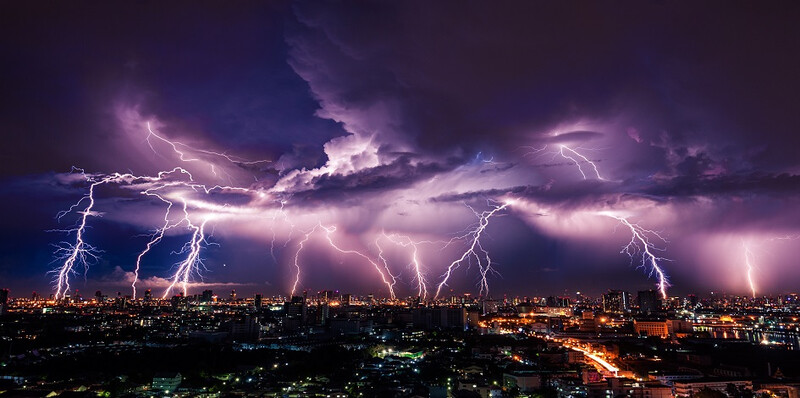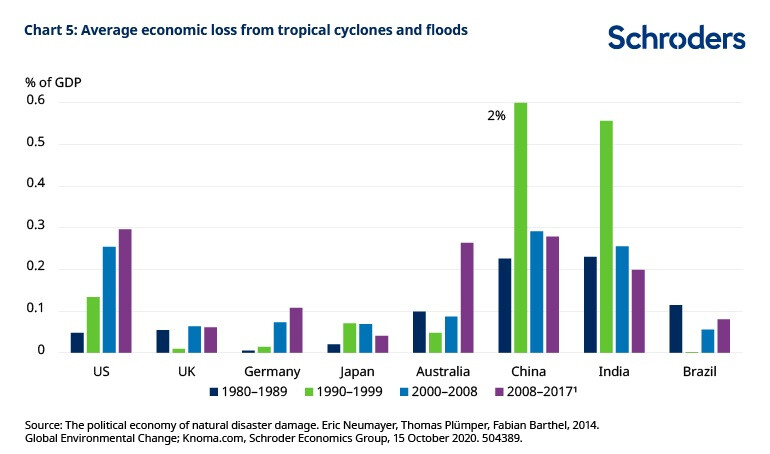What’s the short-term economic impact of climate change?
It’s not just over the long-term that climate change can cause economic damage, looking at extreme weather events we also see it has a short-term impact too.

Authors
The combined land and ocean temperature has increased at an average rate of 0.07°C per decade since 1880. However, since 1981 the average rate of increase has more than doubled (0.18°C ), according to the US National Oceanic and Atmospheric Administration (NOAA) 2019 Global Climate Summary. This extra heat is responsible for regional and seasonal temperature extremes, melting polar ice caps and heavier rainfall.
As climate change represents a relatively slow shift in average weather patterns, we’ve previously looked at its impact on productivity over 30 years.
Here, we investigate its shorter-term effects.
Hurricanes Harvey, Irma, Katrina and Sandy have already shown how damaging climate change can be today. They are some of the most visible examples of the short-term consequences of a warming world, with Katrina (2005) being the most economically devastating hurricane for the US, causing $170 billion of damage according to the US NOAA.
We think it is important for investors to look at the short-term consequences of climate change. We want to bring attention to the economic loss caused by the two most damaging of weather-related events: tropical cyclones and general floods.
Chart 1 shows the significant increase of these weather-related events over the past decades. Globally, the average number of tropical cyclones in a decade has gone from 14 to 23 since the start of the 1980s, while the number of floods has almost doubled.
Extreme weather events to become more severe
In its Fifth Assessment Report published in 2014, the Intergovernmental Panel on Climate Change (IPCC) reported that risks associated with extreme events will continue to increase as the global mean temperature rises.
Higher temperatures will warm the sea. This will result in more heat energy, which will increase the potential for tropical cyclones to develop. As warming also leads to more evaporation, heavy rainfalls and snowfalls become more frequent, making floods and cyclones more severe.
The NOAA found that tropical cyclones have become wetter, more destructive and more frequent in the past four decades, with warming ocean temperatures causing more intense storms. According to the NOAA’s model projections for a 2°C global warming , the intensity of tropical cyclones globally will likely increase by 1 to 10%, while precipitation rates will rise by about 14%.

What’s the economic damage?
It is clear that weather-related disasters have disruptive and often devastating consequences for people and the environment. However, assessing their economic impact is a challenging task due to lack of data availability, measurement issues and their volatile, unpredictable nature.
Here, we want to quantify the economic loss from two of the most damaging extreme-weather events: floods and cyclones. It is also important to note that we focus on the direct economic loss, i.e. damage to buildings and infrastructure and production losses if the disaster interrupts economic activity. We therefore do not take into account the indirect damage coming from mortality, famine, water stress, migration and losses following the breakdown of supply chains.
Using the Munich Re database, which is considered one of the most reliable and complete databases on this matter[1], we find that the average economic loss from these natural disasters has been increasing over the last few decades for the majority of countries considered.
In particular, the average damage caused by floods in the US was around $4 billion in the 1990s, up from just $360 million in the 1980s. The average damage in the first decade of 2000 was still substantial, accounting for more than $1.2bn.
Among the countries we analysed, China seems to be the one most affected by general flooding, with an average loss of $11 billion in the 1990s and $3.6 billion in the first decade of this century.
Among the countries considered, the US is the most affected by tropical cyclones, recording an estimated damage of $24 billion in the first decade of 2000, up from $2 billion in the 1980s. China and Japan also registered significant damages from tropical cyclones, while European countries like Germany and the UK did not, as they are not exposed to a tropical climate.


Is climate change playing a role in increasing disaster damage?
Many factors contribute to the economic damage. Clearly, the intensity and the frequency of the extreme event matter. But changes in population, exposure of people and assets that lie in the path of weather-related events, and vulnerability are also important determinants of loss. Clearly as a country develops and grows over time, more assets and people are exposed to the weather event.
Settlement patterns, urbanisation, and changes in socioeconomic conditions have all influenced observed trends in exposure and the susceptibility of the exposed elements to climate extremes.
The academic literature on climate economics suggests that increases in populations, economic wealth and developments in high-risk areas have been a key driver in the observed increases in losses, but the observed increase in heavy precipitation and in cyclones’ strength may have also played a role.
Chart 4 below clearly shows how the average hazard magnitude of floods has significantly risen since the 1980s for most countries we consider.

While the evidence is clear that the destructive power of tropical cyclones and floods has increased since the 1980s, the magnitude of economic loss critically depends on accumulation of wealth. Higher losses could simply reflect more assets with potential to be damaged or destroyed . The loss record has to be normalised in order to understand if climate change plays a role in increasing disaster damage. The chart below shows that even after adjusting for changes in wealth (we use GDP as a proxy, since wealth and income are highly correlated with one another), there is still an increasing trend in average natural disaster damage over time.
The average loss to GDP in the second decade of 2000s is higher than the average loss in the 1980s for most countries considered, leading us to conclude that climate change has become more damaging for the economy in the past four decades.

Does the economic loss persist over time?
Some parts of the literature on climate change economics suggest that natural disasters could actually boost corporate productivity and promote growth in the long-term. This is because firms that survive the disasters will update their capital stock and adopt new technologies. This hypothesis that disasters stimulate growth is called “creative destruction”.
A recent study[2] which analyses countries’ physical exposure to the universe of tropical cyclones during 1950-2008, finds strong evidence that national incomes decline, relative to their pre-disaster trend, and do not recover within 20 years. This seems to be explained by the fact that disasters temporarily slow growth by destroying capital, but no rebound occurs because the various recovery mechanisms fail to outweigh the short-term negative effect of losing capital.
The analysis seems to support the “no recovery" hypothesis, finding that a one standard deviation in a year's cyclone exposure lowers GDP by 3.6 percentage points 20 years later, setting an average country back by almost two years of growth.
While we may think of climate change as being really long-term, our research wants to bring investors’ attention to the short-term economic damage from global warming. The average temperature increase does matter for productivity growth, but our analysis shows that climate extremes also have the potential to hit GDP growth.
[1] Database from The political economy of natural disaster damage. Eric Neumayer, Thomas Plümper, Fabian Barthel, 2014. Global Environmental Change.
[2] The Causal Effect of Environmental Catastrophe on Long-Run Economic Growth. Hsiang, Solomon M. and Jina Amir S., 2013. NBER working paper.
Authors
Topics